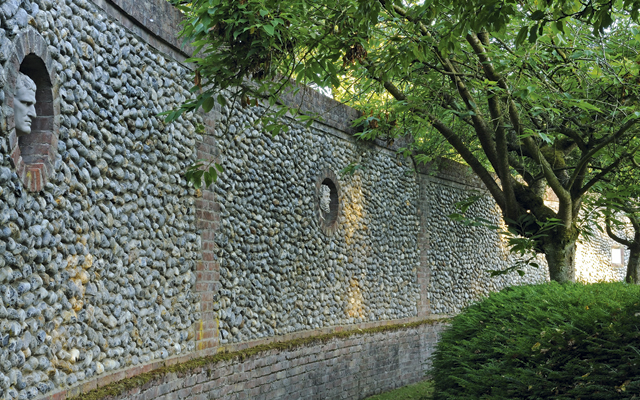Corpusty Mill, Corpusty, Norfolk
Country Life visits an eccentric garden attached to an East Anglian water mill


The garden around Corpusty Mill is deliberately hidden from the world. Corpusty itself is a north Norfolk village on the River Bure, midway between Norwich and the north coast, and it’s partly because the mill is in the middle of the village that Roger Last and his late brother, John, surrounded their garden by high walls and hedges. But it’s also hidden because of the sort of garden it is an intensely personal imaginative world, which contains within its five acres an anthology of architectural styles, a discriminating collection of plants, a series of theatrical set pieces, another of high-spirited jokes and a clutch of (sometimes sombre) ‘fairy tales for adults’.
The mill the oldest parts 17th century, with additions from every subsequent century was acquired after the Second World War by the brothers’ parents, but it was only in the 1960s that serious gardening began. Then, although Mr Last became a director and producer with the BBC, making films on art, architecture and design, and his brother was a marine biologist, they came back to Corpusty at weekends to work on the gradually developing garden.
The site’s great strength and also its great weakness is its abundance of water. Indeed, it’s effectively surrounded by it, the great arc of the Bure forming its roughly eastern boundary (the mill itself actually straddles the river) and the straight line of the mill overflow-stream cutting through it close to its western one. All of the garden has, in fact, been made out of what were water meadows, which, says Mr Last wryly, ‘is fine in dry years, but not in wet ones’. Sections of the garden can still flood or become waterlogged, so plants aren’t easily or quickly established.
The brothers began simply by planting things they liked. However, they rapidly realised that a garden solely of ornamental plants ‘dies in winter, because it has no structure’. That led to the creation of a series of hedges and other permanent structures, which, at first, were simply bought-in commercial products. However, having what everyone else had failed to satisfy them.
Both were as interested in architecture as in plants Mr Last remembers as a child keenly anticipating the prospect of visiting Blickling, ‘which would have bored most children silly’—so they decided to try to design and build their own. ‘We weren’t designing for clients, so we could always change our minds if something didn’t work. We didn’t plan to build follies, but, in effect, that’s what we did.’
Although the garden’s buildings and plantings are very varied, all are governed by three general ideas. First, the brothers felt it was important to manage visual effects ‘with some restraint’, thus hedges and borders were positioned so that only one building showed at a time. Next, to mitigate the possible dullness of an essentially flat site, they created innumerable changes of level, most of which were only modest, but, as Mr Last points out: ‘Even a few feet can make a huge difference.’ Finally, they wanted to create marked changes of mood, so some areas are open and light-filled, but others are densely planted and shaded.
A good example of the former is the area closest to the house, entered past a recent brick column topped by an oak ‘spire’, which will silver with age. An undulating lawn is set off by a small circular pond, an elaborate sunken water garden (its blank arcading filled with French burrstone from the mill) and by the contrast between a curving yew hedge and, behind, the curving wall that marks the garden’s boundary.
Exquisite houses, the beauty of Nature, and how to get the most from your life, straight to your inbox.
The hedge, its buttresses, the metal plinths between them and the elegantly simple central bench (designed by Mr Last) are all coolly Modernist. Above them looms a ‘Picturesque Gothic’ flint wall some 260ft in length, in which roundels have been set, bearing busts of Hadrian, Augustus and Septimius Severus. Built in 1992, it became, ‘in effect, a memorial to my brother’, who had died in 1990.
Other good examples of Picturesque Gothic lie immediately beyond. Deep shade is created by characteristically dense planting, including hydrangeas, mahonias, magnolias and a Metasequoia (a 2ft-high infant when planted in 1963, now a 70ft giant). Mr Last’s explanation for that planting style is: ‘I’m mainly interested in foliage shapes and foliage contrasts, not flowers. And I like big, bold plants.’
Within that shade looms a Gothic arch, which mixes ancient fragments (parts of a redundant stone doorway from Mannington Hall, a window from a demolished Lowestoft church) with the brothers’ own flintwork. Beyond is an even more striking example: the four-chambered grotto, which took 14 years to build in local ginger-coloured carstone.
This was both a response to a practical difficulty beneath a huge horse chestnut, nothing would grow and much more than merely a piece of whimsy. Traversing it involves first a descent into darkness and then an ascent back into the light, suggesting at least a psychological if not a religious progression. (Mr Last happily acknowledges that Bomarzo in Italy has been a huge influence on the garden’s more Gothic effects.)
North of the main lawn, however, is an area in a completely different style. Here is the classical symmetry of a Palladian villa, imitated in miniature in flint and engineering brick on the footprint of the mill’s old grain store. Its central pavilion and side wings (which unashamedly double as the garden’s compost containers) were created in the 1980s, but the flanking blind arcades, the central fountain (to Mr Last’s design) and the raised beds (planted with a suitably Italianate range of plants: lavender, agapanthus, salvias, Echium pininana, lantana) were added only in the past few years.
As Mr Last is ‘concerned that good British gardens so often seem to look to the past’ and ‘as I wanted something interesting to look at from the house in winter’, nearby is the very different formal geometry of a Modernist water garden, in which plants play only supporting roles to its stars an array of stainless-steel pyramids and panels.
All of those areas and several others are somehow fitted without overcrowding into the garden’s central section. Beyond a public footpath north of the house, however, lies one of the two old water meadows, with the other beyond the curving flint-work boundary wall and the road. Both are treated in a similar way, with intricate ‘fringe’ planting of specimen trees and shrubs, but their centres left open.
The open centre of the first meadow is, in fact, a substantial lake, its spoil used to create yet more changes of level, with, beyond it, the striking eye-catcher of a slender 21ft-high stainless-steel obelisk, its sleek Modernist lines a deliberate contrast to the Classical statue of Zeus lurking further back in the gloom of a yew ‘apse’.
The open centre of the second has the focal point of a circle of tall, outward slanting, coloured, wooden poles, which Mr Last jokingly refers to as his ‘Millhenge’. Not at all jokingly, he insists on two final points. First that, intensely ambitious and impressive though this garden is, ‘it wasn’t planned as a whole, but in stages, as our design philosophy gradually developed’. And second, that ‘it isn’t finished. It continues to evolve. There is still much more that I want to do’.
The garden at Corpusty Mill, Corpusty, Norfolk (www.corpustymillgarden.co.uk) is open to groups of 20 or more by appointment, made in writing or by email (rogerlast@corpustymillgarden.co.uk). Mr Last, a past chairman of Norfolk Gardens Trust and the current editor of its journal, is also one of the authors of a comprehensive 450-page book on ‘Norfolk Gardens and Designed Landscapes’, published in 2013 by Windgather Press, an imprint of Oxbow Books (www.oxbowbooks.com)
* Follow Country Life magazine on Twitter
